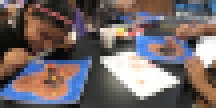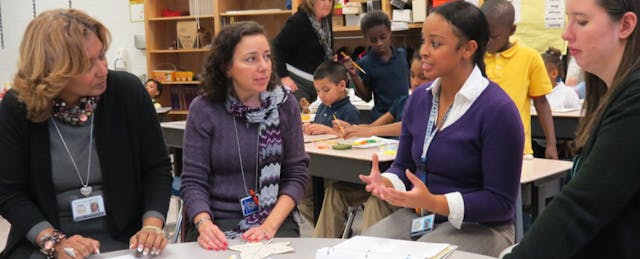LAS VEGAS — Inside a science lab here on a scorching summer day, 27 kids sit in small groups itching to get started on the day’s science activity: putting finishing touches on their model volcanoes.
Vicky Zblewski, a 12-year veteran of the 4th-grade classroom, stands at the front of the room wearing a Hawaiian shirt studded with erupting volcanoes, as she reviews some volcanology basics (What is a cone volcano? Does it have thin or thick lava?). She walks around the room asking kids questions about their creations, sculpted in white modeling clay. “Think about where your lava is going to go,” she advises, as kids start brushing on coats of black and brown paint and rivulets of red dripping off the sides.

Thus goes a typical, hands-on science lesson at Walter Bracken STEAM Academy, a public magnet located about two miles north of the casinos of Fremont Street and the downtown core. More than 60 percent of students are on free or reduced lunch, yet Bracken is one of the top performing elementary schools in the city and ranks in the top two Title I schools in the state.
“We became a STEAM academy five years ago and we knew the arts were really important,” explains Vice Principal Michelle Wheatfill, dropping the buzzword that stands for Science Technology Engineering Arts and Mathematics. “But we weren't actually seeing how that was translating into general-ed classrooms.”
Students would attend special art and music classes weekly, but there was little thought given to how math or science class could benefit from painting or building with Legos in an integrated way. That all changed when the school took eight teachers to a Title I conference two years ago—a reward for its top performance.
Teachers were encouraged to wander around and soak up the conference, but Zblewski, who was recovering from knee surgery, parked herself with colleagues in a room set up by Crayola to highlight its creatED series of professional development workshops, which cover art integration, creative leadership and breaking down science and math concepts visually.
After the conference, teachers at Bracken—a school that prides itself on its democratic approach to decision making—decided to give it a shot. “I liked that it was making it not so scary to add art to your curriculum,” says Zblewski, whose volcano project was inspired by the program.
Hands-On Learning
Begun just last year, the creatED workshops mark a new focus for Crayola, which was founded as an education company before shifting gears to capture a broader consumer market. If activities that involve making and painting volcanoes out of art supplies seem decidedly low-tech for a series so heavily invested in STEAM—an acronym that features technology as its second letter—that’s not by accident. The goal of the workshops is to get learners thinking about the concepts that power technology in a tactile, hands-on way, even when they’re not using any.
Take a workshop lesson titled “unplugged coding,” which is designed to demystify the logic behind computer science. Teachers act out a set of commands like a game of charades—step forward three times and turn left—and their peers try to draw what they see to replicate the sequence. “The big learning is that coding is visual communication,” says Cheri Sterman, Crayola’s director of education. “With teachers we talk about how they’re literally using algorithms to do storytelling,” she says.
The workshops are aimed specifically at K-8 teachers and hone in on activities heavy on paint, clay and markers, like the ones kids might tackle in the classroom. One portion asks small groups to work together and create hanging mobiles to illustrate science concepts. Others showcase design thinking principles or how to think like scientists during a project-based lesson.
After the workshop, teams get workbooks full of ideas on how to make their thinking visual, Sterman says. “They’re filled with classroom application ideas, assessment rubrics, and planning frameworks.” The workshops also heavily promote the use of Crayola products, and at the end participants leave with bags outfitted, naturally, with Crayola supplies.
While all the workshops center around hands-on making, schools can choose one of three focus areas: STEAM; visual literacy, which includes math and reading concepts; and creative leadership.
That last area has proven a crucial bit of marketing savvy to get school leaders in the door, according Pamela Fossett, who leads the education policy and professional practice department at the Alabama Education Association, and has conducted creatED workshops for Crayola. Somewhat unconventionally for a teacher workshop, Crayola strongly encourages principals to attend side-by-side with coaches and staff, and both leaders and teachers are taught to spread concepts and activities to the whole school.
“The creative leadership piece is really used to target our principals and assistant principals because in Alabama they have to earn professional learning units to keep their licenses current,” Fossett explains. “We just called it a creative leadership initiative so that principals would be engaged with teachers and not think, ‘Oh, this is just some little frilly activity.’”
In an era when teachers and schools are benefiting big from brand associations with education companies, outreach from companies like Google has raised alarms that brands are marketing themselves straight to classrooms (and future consumers). Crayola is certainly putting marketing muscle behind creatED. But everyone interviewed for this story indicated that teachers were driving much of the program's momentum in schools. The challenge for the company is not name recognition but awareness that the workshops exist.
Before she started facilitating workshops, Fossett was unaware the company was even involved in professional development. It's a sentiment she hears often when she talks to teachers. “A lot of my participants at the end of Day One told me, 'We had no idea Crayola was doing this,' and I was like, 'Yeah, me too,'” she says. “They relate [the brand] with the crayons and the markers,” she says.
Like Bracken, many of the attendees at Fossett’s workshops in Alabama came from Title I schools, an area Crayola is heavily invested in reaching. In addition to its presence at the annual conference, the company encourages schools to use their Title I funds toward its workshops and even offers an online guide spelling out how the program aligns with various buckets of federal money, including Title I.
Wrapped into that is a related push for making home-school connections. The unplugged coding lesson, for example, was turned into an activity for families to work on together as part of a take-home kit.
“A major portion of the Title I mission is to make sure families and educators are co-educating,” Sterman says. The lesson still focuses on sequencing and math but with some key adaptations. Standards are referred to as “big ideas,” and there’s a focus on getting families learning together. “They’re having fun and it aligns with the vocabulary in these grades,” she says. “It boosts parents’ confidence in these ideas.”
Wheatfill, the vice principal at Bracken, sees the hands-on focus on integrating the arts into core subjects as a confidence builder for educators, too. “Not everybody sees themselves is an artist or feels like they're creative or even knows where to begin,” she says. “That holds them back. That's where the mindshift is.”


